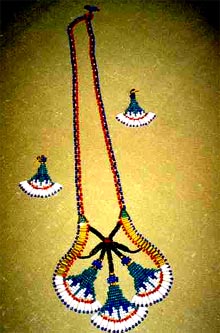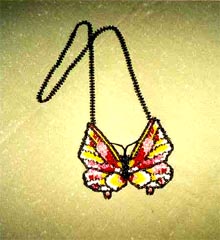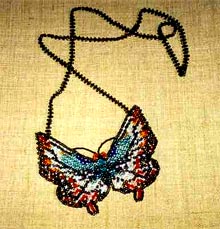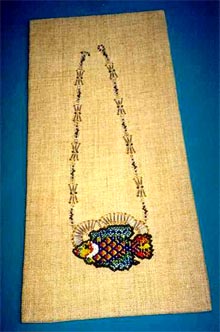|
|
On the pic above you can see the fragment
of beadwork. A head of an ancient heavy-armed soldier from the times of
the Rome empire puissance seems to be coming from the photo-picture, where
Timothy Dalton's Julius Caesar from mini-serial "Cleopatra" commits to
attack his cavalry!
This is amazing material, I mean - the bead.
The technique of this ancient art is very interesting too, but in a greater
degree - those, who saves and develops these glorious traditions of
backward nowadays.
For the beginning let's consider some
historical facts.
The Beadwork's History
This is what I could know about it from the
small, but very informative and useful book /L.1/.
"It is well-known fact, that ancient Egypt and
India are the bead's birthplace. There were different techniques of making
bead and chaplet.
The first one was: the melted glass was drawed
out into the tenuous thread and wrapped around the copper rod. It's
thickness was equal to the hole in the bead. Then the rod was extracted and
the bead was hot up again with the hand work after that. Another method
included foliation of a glass thread into a glass strip, which was then used
for enlacing around a metal wire. Side seam was flattened and the tube was
cut into into the pieces of needed length. Then the bead was worked by hands.
Diaphanous glass appeared later and the
technique of blowing was discovered. The process of glass bead production
became the one of many sorts of glass manufacture. The years passed until
the moment when the bead from a metal, porcelain and plastic appeared�
In ancient Egypt opaque glass was the material
for making artificial pearls, named "buser" or "busra" - the ancient name
of the small and a little bit flattened beads. The beautifications, braided
from bead in ancient Egypt and India, had a high rank in the clothes of many
peoples in countries of Near and Far East, in Africa, in American continent
and islands of Pacific Ocean, in Europe and in Asia.
There were different manners to use the bead
beautifications: the only one or some ones simultaneously, every day or only
on holidays, from childhood and to old age or only in the years of youth.
Very often in regions, where they were produced, beatifications served as a
part not only for women but men clothes or dress too. These ones were made by
hands or using special tool, to thread a hundred beads in a pattern with
coarse thread, horsehair or thin wire.
On the territory of Russia glass-ware is known
from the VI-V centures B.C.. In the times of Kievan Russia women and children
use beautifications in the forms of glass chaplet and bracelets of different
shape and colour. Not only foreign Byzantine bead was used to beatify clothes
by jewellery. There was used the bead from Russian little glass works and
Russian gemstones. Only in the XV century for making cultic needs things
(church clothes and plates) or things for Royal family the needlewomen began
widely apply foreign Venetian bead, joining it with gemstones and Russian
pearl.
Beginning from the XVII century the bead,
imported from Venice and East Bohemia (North Czechia), began to be used in
home needleworks and in beautification of national costume. Women and girls
wore long ribbons of pendants and the collars of open work, belts and earrings.
They beautified their head-dresses with fringe, and with many others special
things. The long strips of pectorals were called in Russia "guytun", though in
Ukraine they were called "gerdun" - from Turkic and Iranian word "neck".
In the end of 19 - beginning of 20 century
beautifications of Russian peasants were known far outside their own country
due to their different and bright colour, really native motives, varity of
shapes and compositions. They were exposed in the international exhibitions
and fairs, were sold at the homecraft shops. Our samples were used for
teaching at the fancywork schools in Germania, France, Austria, England,
Italy, USA and Australia.
After the October revolution, at the
times of civil war (1918-1922 years) the workshops for work with bead and
schools for past mistresses were closed, but the love to bead traceries saved
for many peoples up to date. In 70-s of 20 century bead work began to rise
again. And now, like in the years "od ancient times", we can enjoy again
with the creatioms of our masters!"
Let's examine now some works of Masha Zolotova,
who has given some years for investigating this ancient art and made with her
own hands a number of unrepeatable things!
Beautifications for Cleopatra
When in 1998 we have known about new set of
"Cleopatra" with the participation of Timothy Dalton as Julius Caesar, the
interest to the theme of ancient Egypt in our circles has awaked again.
Admiers of dramatic arts began to study a legacy of passed years with the help
of video, literary men and women reread everything, what they could find about
Cleopatra and both her outstanding lovers - Caesar and Antony, but Masha
composed to create the beautification, which ones literally could be wore by
the great woman and empress during that times.
It's well known, that ancient Egyptians worshiped
Gods, who symbolized the Sun. Amon-Ra and his son Horus were the two main gods
in ancient Egypt. The red circle or winged circle, i.e. circle with the wings
of falcon, was a symbol of Horus and had defencive function at the ancient
amulets and talismans. As it was thinking of Pharaohs that time, they were
vicegerents of God on the Earth. That is why Masha put the symbol of a red
winged circle or a falcon in sailing flight into the centre of her composition
for empress Cleopatra.
Learning the art of ancient Egyptians, Masha
found, that using of more than two different symbols is one of the characteristics
for the culture of those days. What can be more suitable for this purpose,
if not the image of beetle-scarab, sacred insect, produsing something ideal
and similar at it's shape with the Sun itself, i.e. with Amon-Ra, and in
combination with the first symbol giving "succession of authority" and
"continuance of stirps"?

To finish the composition it was need to add
the two elements else: the images of sickle moon and "anh", this comprehensible
for Egyptians symbol, combined the circle (the sign of eternity) and cross
(the sign of being). As the ancient people thought, the cross meant the
alliance of sacred and profane, male and female (Asiris and Isida). Egyptians
wore this sign in their amulets. They thought, that the cross protects them
against death. "Ankh" signed immortality. Masha put two such elements along
the both sides from scarab and on the equal distances from the beetle and the
center of connecting whole work chain.
The image of sickle moon You will find in the
legs of bird-falcon. The fact is that, in the religion of ancient Egypt the
Moon identified with the God Tot - the vicegerent of Amon-Ra at the night
time. He symbolizes the heart of supreme God Amon-Ra. Tot is the world ruler
of wisdom, written language, counting and time.
On the colour photo-picture of this holiday
necklace under the name "Scarab" you can see all palette of this
beautification, which carries with itself the certain semantic charge:
gold - the colour of empress authority, red - the colour of Sun, blue - the
colour of truth.

But the epoch of ancient Egypt is not the time
for worship of all-powerful Gods, this is a period of intensive development
for lore - the practical knowledges and crafts. That is why Masha called her
second bijou for Cleopatra - "Papyri". This sacred and beautiful plant held a
high position in Egypt's life: the material to produce the clothes and
footwear, floatable boats and the "paper" for writing. Joining of beauty and
utility - this our ideas about that far epoch. But it would be incomplete, if
Masha didn't remind us of Cleopatra's might with the two gold flake fragments.
They brace papyrus flowers. This is the symbolic image of uraeus - the sacred
snake, the sign of invincibility for empress power. For Cleopatra this sign
has additional meaning. Like the finger of Fate it reminds of Cleopatra's
death. She stepped out as unvanquished person, with a snake in her bosom.
It's interesting, that the papyrus flowers,
repeated in the tracery of eardrops, are certainly stylized under an ancient
ornament or a symbolic image of this plant. This gives us the suprizing
feeling of nearness to that epoch, where the immortal heroes of Shakespearian
tragedies, epics and miniseries lived, fought, loved, triumphed and died.
Watch "Cleopatra" once more, but now - through the the perspective of Masha's
works. Probably it will seem to You a little bit more near and comprehensible!
Fairy Butterflies and Black Orchids

The story of Basil St John from the movie
"Brenda Starr" about black orhids, which must be grown by the members of his
family to save themselves from the mysterious, cureless and heritable disease,
only in the mouth of Timothy Dalton could take something of the elements of
decisivity or at least to be remembered for making associations with the
Garden of Eden, outlandish plants, marvellous birds and butterflies of unusual
beauty. Masha made these butterflies in such a way. Is it wonderful? What a
dainty addition to the story and� what a beautiful bijou!

Mashs didn't forget this movie's heroine. How
much suitable to her dresses during the travel along South America is necklace
"The Bolivian Cockerel", made in the style of traditions of Indians in Latin
America!

The Magic Fish

From the ancient times the fish in Russia was
the symbol of success and the propitious omen. That is why the falktales used
this imsge very often. Do you remember quarrelsome old woman from Pushkin's
"The Tale about Fisherman and Fish", who managed to to make the marvellous
habitant of sea angry and "to stay near the broken washtub"? But how much the
magic luce repaid the village fellow Emelia, who has accidentally caught her
with the water in his bucket when took it from the water-hole, but liberate
her. By the way, in the one of his interview Timothy Dalton told about his
lovely fishing, that he likes the process of watching, how the fish finds the
bait and makes preparations to devour it, but when the fish is caught,
Timothy liberates her.
Masha tells, that she lately wished to use
the bead for demonstrating its natural material's facture as a mean to show
the gloss of the fish shining scales and nacres. But this was Timothy's
interview, that gave a nudge to create this little miracle.
Let's wish Masha Zolotova and Timothy Dalton
to be always like the fish in a water on their own ground!
List of reference
1. A.N.Litvinets. And You See Wonderful Tracery!
-�. "The Young Guard", 1988. - 94p., ill.
�.�., 2000

[Good Feelings]
[Poetry]
[Prose]
[Quilt]
|
|